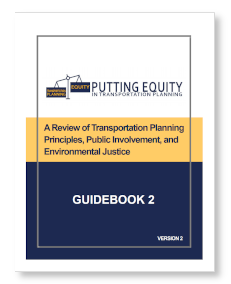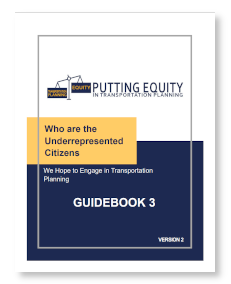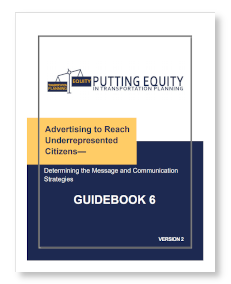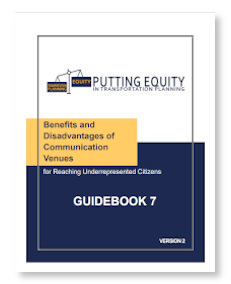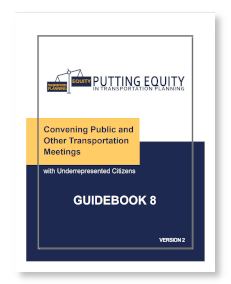Transportation
Suggested Practices for the Transportation Planning Community
Suggested Practices for the Transportation Planning Community

Doing Things Differently
Moving beyond transportation planning’s traditional public participation approaches to engage underrepresented citizens can open pathways for meaningful understanding, input, involvement and discussion. From December 2019 through June 2021, this Transportation Equity Project developed and tested new learning tools that feature strategies for “doing things differently” to enhance engagement between transportation planners and underrepresented citizens in Morgantown and Monongalia County.
West Virginia’s underrepresented population—including low-wealth, minority, seniors, disabled, and people without houses—suffer poor health, poverty, food insecurity and economic challenges that are aggravated by insufficient access to affordable, reliable transportation services. West Virginia’s lack of roads, transit, and pedestrian infrastructure exacerbates the community’s rate of food insecurity, poor nutrition, obesity, diabetes, traffic injuries and death.
Engaging underrepresented groups in transportation planning and decision making is critical to addressing these issues. West Virginia’s transportation planning agencies strive to meaningfully engage these populations; however, underrepresented citizens can be hard to reach and may be navigating day-to-day struggles that make their participation in civic activities difficult. They may not realize that their input into transportation planning can help improve the quality of their lives and neighborhoods.
The new learning tools in this project’s Transportation Equity Toolkit are designed to assist transportation planners to more meaningfully engage underrepresented citizens in transportation planning:
- A series of Guidebooks addressing transportation equity and featuring communication, engagement, and creative placemaking approaches for reaching, interacting with, and conducting meetings with underrepresented citizens;
- a Training Module and PowerPoint Presentation for teaching the transportation planning process to these citizens.
You will find this content here in draft form. The Guidebooks, Training Module and PowerPoint (all labeled Version 2, 6/2021) have been updated from the original versions based on feedback from West Virginia transportation planning experts, selected pilot testing, and new input from social service agency personnel in Morgantown and Monongalia County.
When underrepresented citizens’ voices are missing from planning efforts, their transportation problems and needs often remain unidentified and unmet. As a result, transportation solutions can fail to serve the entire community by, for example, focusing on moving cars from point-to-point vs. considering multiple modes of transit such as buses, pedestrian or bicycle pathways that may meet the needs of the broader community. Doing things differently and using new communication, engagement, and creative placemaking approaches can help ensure all voices are represented in the transportation planning process. Creative place-making and other strategies recommended in these materials can help achieve transportation planning that is community driven, rooted in public participation, and embraces the community in its entirety.
We would like to receive any feedback you may have about the Guidebooks and Training Module. You may email Dr. Andress at landress@placeandhealthwv.com.
We plan to develop additional, enhanced and/or updated materials based on future focus group feedback, additional pilot testing, any ideas that we receive, and interviews with our community experts.
THE TRANSPORTATION EQUITY TOOLKIT
These materials are designed primarily for transportation planners but can be used by any person—including transportation agency staff members; engineers; local planners; local leaders; board and committee members; and social service agency personnel—who wants to learn more about transportation equity, ways to enhance interactions with underrepresented citizens, or how to teach the transportation planning process to underrepresented groups. The materials focus on the geographical areas of Morgantown and Monongalia County, West Virginia, which are served by the Morgantown Monongalia Metropolitan Planning Organization.
Guidebook 1: Defining the Transportation Planning Problem and Doing Things Differently—defines the transportation planning problem as it relates to underrepresented citizens, describes transportation equity, and offers suggestions for doing things differently to address transportation planning and equity issues.
Guidebook 2: A Review of Transportation Planning Principles, Public Involvement, and Environmental Justice—offers a brief overview of “transportation planning in service to the community” and discusses public input and environmental justice requirements for transportation projects.
Guidebook 3: Who are the Underrepresented Citizens we Hope to Engage in Transportation Planning—offers information about underrepresented citizens and how lack of access to transportation services creates daily challenges in securing basic necessities like food, health care, and getting to work, school, appointments and other important places.
Guidebook 4: Who Can Use the Transportation Equity Project’s Training Materials and How to Teach Using Lesson Plans—presents a brief overview, about using the Training Module for Teaching the Transportation Planning Process to Underrepresented Citizens: “Why Getting Involved in Transportation Planning is So Important,” especially for new trainers. It explains who can use the materials, strategies for teaching adults, and how to use lessons plans that offer step-by-step instructions for teaching each topic.
Guidebook 5: Reaching and Engaging Underrepresented Citizens through Their Trusted Allies and Advocates—offers suggestions for reaching and engaging underrepresented citizens through their trusted allies and advocates, based on recommendations from Morgantown and Mon County social service providers.
Guidebook 6: Advertising to Reach Underrepresented Citizens—Determining the Message and Communication Strategies—offers suggestions for crafting effective messages and selecting appropriate communication venues—print, broadcast, social media, face-to-face, etc.—for reaching underrepresented citizens.
Guidebook 7: Benefits and Disadvantages of Communication Venues for Underrepresented Citizens—identifies, describes and presents benefits and disadvantages of a wide variety of traditional and non-traditional communication venues.
Guidebook 8: Convening Public and Other Transportation Planning Meetings with Underrepresented Citizens—recommends strategies for holding, designing, and conducting public meetings so that they are more accessible, understandable, and welcoming to underrepresented citizens.
Training Module for Teaching the Transportation Planning Process to Underrepresented Citizens: “Why Getting Involved in Transportation Planning is So Important”—guides an instructor through the process of teaching the transportation planning process to underrepresented citizens in a classroom setting. Topics include: (1) how the local transportation planning process works and why it is important for underrepresented citizens to participate, (2) the three phases of the local transportation planning process, and (3) why, where, when, and how underrepresented citizens can provide input to the transportation planning process—to address both long-term and short-term transportation needs.
 PowerPoint Presentation for the training module, “Why Getting Involved in the Transportation Planning Process is So Important”—PowerPoint slides designed to accompany the training module.
PowerPoint Presentation for the training module, “Why Getting Involved in the Transportation Planning Process is So Important”—PowerPoint slides designed to accompany the training module.


